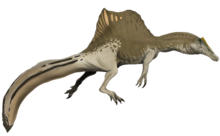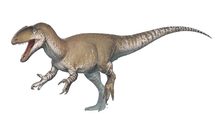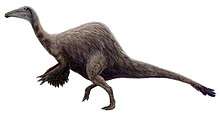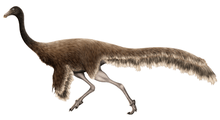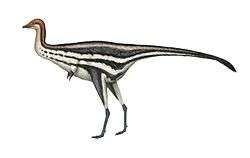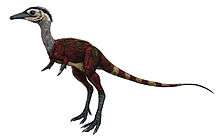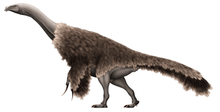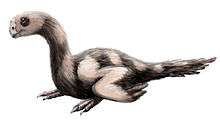Zuolong
Zuolong (Zuo's dragon) is a genus of coelurosaur dinosaur which existed in what is now Wucaiwan, Xinjiang Autonomous Region of China during the Late Jurassic period (lower Oxfordian stage).[1]
| Zuolong | |
|---|---|
 | |
| Skeletal diagram of known material in white and light grey | |
| Scientific classification | |
| Kingdom: | Animalia |
| Phylum: | Chordata |
| Clade: | Dinosauria |
| Clade: | Saurischia |
| Clade: | Theropoda |
| Clade: | Tyrannoraptora |
| Genus: | †Zuolong Choiniere et al., 2010 |
| Species: | †Z. salleei |
| Binomial name | |
| †Zuolong salleei Choiniere et al., 2010 | |
Discovery
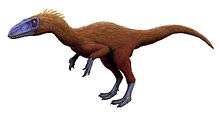
The holotype fossil of Zuolong, IVPP V15912, a partial skeleton with skull, was discovered in 2001 in China, in the upper part of the Shishugou Formation of Xinjiang. It was a subadult animal which measured approximately 3.1 metres (10 ft) in length and weighed up to approximately 35 kilograms (77 lb). Zuolong was named by Jonah N. Choiniere, James M. Clark, Catherine A. Forster and Xu Xing in 2010, and the type species is Zuolong salleei. The generic name honours General Zuo Zongtang, who secured Xinjiang for China in the nineteenth century. The specific name honours Hilmar Sallee, whose bequest helped finance the research.[2] The specific age for the holotype specimen is 161.2 to 155.2 million years ago. The holotype is considered by Thomas R. Holtz Jr. to be from almost certainly a juvenile theropod.[3]
Description
In 2016, Gregory S. Paul estimated the length of Zuolong at 3 metres (9.8 ft), and its weight at 60 kilogrammes.[4] The specimen is probably from a juvenile animal, and is quite complete.[3]
Classification
Zuolong is a primitive coelurosaurian, possibly the most primitive known.[3] In 2019 it was found to be a member of Tyrannoraptora in a polytomy with Tyrannosauroidea and Maniraptoromorpha.[5]
References
- Choiniere, Jonah N.; Clark, James M.; Forster, Catherine A.; Xu, Xing (2010-12-02). "A basal coelurosaur (Dinosauria: Theropoda) from the Late Jurassic (Oxfordian) of the Shishugou Formation in Wucaiwan, People's Republic of China". Journal of Vertebrate Paleontology. 30 (6): 1773–1796. doi:10.1080/02724634.2010.520779. ISSN 0272-4634.
- Jonah N. Choiniere, James M. Clark, Catherine A. Forster and Xing Xu (2010). "A basal coelurosaur (Dinosauria: Theropoda) from the Late Jurassic (Oxfordian) of the Shishugou Formation in Wucaiwan, People's Republic of China". Journal of Vertebrate Paleontology. 30 (6): 1773–1796. doi:10.1080/02724634.2010.520779.CS1 maint: multiple names: authors list (link)
- Holtz, T.R. Jr. (2012). Dinosaurs: The Most Complete, Up-to-date Encyclopedia for Dinosaur Lovers of All Ages. Random House. pp. 367–444. ISBN 978-0-375-82419-7.
- Paul, G.S., 2016, The Princeton Field Guide to Dinosaurs, second edition, Princeton University Press p. 120
- Hartman, Scott; Mortimer, Mickey; Wahl, William R.; Lomax, Dean R.; Lippincott, Jessica; Lovelace, David M. (2019). "A new paravian dinosaur from the Late Jurassic of North America supports a late acquisition of avian flight". PeerJ. 7: e7247. doi:10.7717/peerj.7247. PMC 6626525. PMID 31333906.



